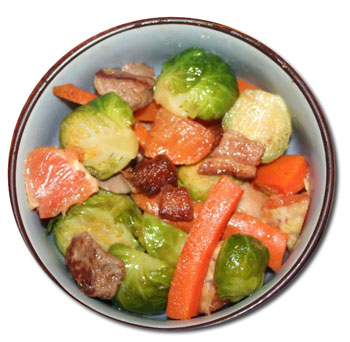|
|
Cut thine sproutsby Ari Levaux Of course, one need not choose between pork and raw greens. The two have shared many a plate, and it probably won’t be long until bacon grease vinaigrette becomes the next “it” dressing. However you like to prepare your sprouts, the fundamentals are the same. And the foundation of most successful Brussels sprout dishes is that the sprouts are cut in half. Cutting Brussels sprouts in half multiplies the ratio of surface area to volume, which is key when it comes to holding sauce. The many layers of tightly wrapped leaves exposed by a halved sprout can hold a surprising amount of flavor. Conversely, the tightly wrapped leaves form an almost impermeable barrier that repels sauce or dressing like water off a freshly waxed car. The sauce has no access to the sphere’s inner folds and can only wait helplessly on the sidelines. Unless, of course, you like the flavor of full-on, unadulterated sprouts. You can cut beyond half if you wish, but it isn’t necessary. If you’re going to chop them finely you might as well use cabbage. Raw Brussels sprouts are too strong for most palates, so they generally need to be cooked before you toss them in a greasy pan or a salad bowl. My two favorite ways of cooking Brussels sprouts are roasting and steaming. Roasting gives them a weathered taste. The dry heat cultivates extra flavor as the outer leaves develop a brown crisp. Steaming sprouts preserves a certain clean, bright innocence in them, the better to deflower with bacon grease, ranch dressing or a mix of olive oil, salt and vinegar. Growing Brussels sprouts is a grind. They take a long time to mature, and don’t produce much poundage per plant. That’s why they’re expensive, and why each sprout should be groomed like the treasure it is. Trim the cut end at the bottom of each sprout to create a new, non-browned end, and pull off the outer leaf or two if they’re brown, yellow, dirty, shriveled or otherwise tainted. What remains are densely-packed layers of green and pre-green yellow. Steamed, they only need 5 to 10 minutes, depending on the sprouts’ thickness, until they soften all the way through but retain the rich green glow of spring grass. Whether you steam or roast is entirely dependent on the final dish. If you plan to fry them in bacon grease, a quick steaming is way less trouble. For salad, the rough, rich flavors of roasted Brussels add bold contrast to the leafy greens. If cooking Brussels sprouts with other vegetables, just make sure everything is cut to a size that allows it to cook at the same rate. To accompany Brussels sprouts in a salad, I go for sturdy greens like romaine or endive, and a dressing of equal parts olive oil, cider vinegar and soy sauce. Some or all of the cider vinegar can be replaced by balsamic if you prefer. Just remember, we don’t have to put balsamic on everything like it’s the new bacon. One snazzy way to liven up a winter salad is with seasonal fruit. Even if you don’t live anywhere near the citrus orchards of Florida, Arizona or California, you can eat seasonally, if not locally, in winter. Chunks of orange or grapefruit add nice acidic sweetness to a Brussels sprouts salad, as do pomegranate seeds. And about that bacon vinaigrette. Any salad can be made omnivore-friendly by preparing the Brussels sprouts with bacon prior to adding them to the salad. That bourbon shot is the secret, by the way. From hunting camp. Share it wisely. Season with black pepper and hot sauce, and add the above dressing of vinegar, soy sauce and olive oil. Toss the sprouts to maximize their uptake of dressing. Add the meaty, greasy sprouts to your salad, or pop them straight in your mouth. After hanging on their stalks like bare knuckles in farm fields through late autumn, Brussels sprouts can be stored all through the winter under proper conditions. If more people knew how to cook these tight wads of bitter leaves, maybe Brussels sprouts wouldn’t be such a symbol of vegetable-hating. |
In this week's issue...
- September 11, 2025
- Back on top
After harrowing flying accident, local highliner steps back out with renewed mission
- September 11, 2025
- New order
Rule change for Land and Water Conservation Fund raises alarms
- September 4, 2025
- Armed with knowledge
Local community organizers work to ensure immigrant neighbors know their rights


